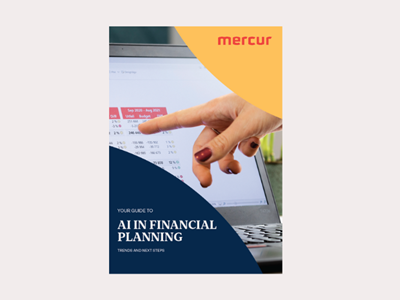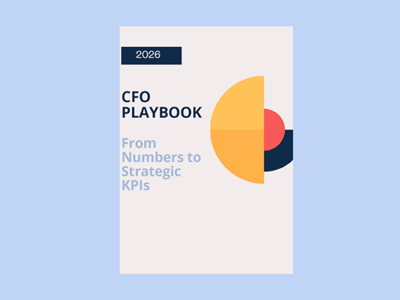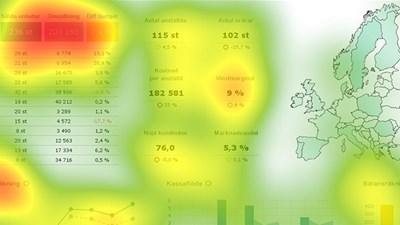
The Business Benefits of Integrated Business Planning
Companies today face mounting pressure to align strategy, operations and finance for sustainable growth. Traditional planning methods, often siloed and fragmented, can no longer keep pace with market volatility and rising stakeholder expectations.
Without unified direction, organisations risk inefficiency, missed growth and falling behind in today's competitive market. This is where integrated business planning (IBP) can help.
This blog explores what IBP is and the typical IBP process. We'll highlight the tangible business benefits and how the right software can be a game-changer for your organisation.
What Is Integrated Business Planning?
Integrated business planning is a strategic management process that connects and aligns business operations with financial goals. This brings together departments such as sales, marketing, finance, supply chain and operations.
Rather than planning in isolation, IBP ensures that your teams work from a single, unified view of the company's performance and future direction. The main objective of IBP is for businesses to maximise their profit and take minimal risks. It identifies the common connections of business plans and determines long-term strategy.
Unlike the traditional Sales and Operations Planning (S&OP), which focuses mainly on balancing supply and demand, the integrated business planning process brings together both strategic vision and day-to-day operations. This is to ensure that every department works towards the common goals of your organisation. It's a unified approach that helps companies to better predict and respond to changes in the marketplace.
Why Integrated Business Planning Matters
IBP fosters collaboration across departments and helps to break down barriers. At the same time, it encourages your teams to share information and align their planning, accounting practices and data management.
Another core element of IBP is the seamless data integration and performance tracking throughout your organisation. It is used as a solid foundation for informed decision-making and continuous improvement.
Financial integration is equally important, as it allows organisations to gain a clear understanding of their overall financial health. The consolidation of key performance indicators from each department into a single, comprehensive view helps your teams make more effective, data-driven decisions.
The Integrated Business Planning Process
A successful integrated business planning process follows a structured and iterative framework. While each organisation may tailor the steps to its unique needs, the typical IBP includes the following:
Data collection and analysis: Gathering relevant data such as sales forecasts, production capacity, inventory levels, financial projections and market trends from all departments. This will form the foundation for accurate integrated planning.
Demand planning: Teams predict future demand by using historical data, market analysis and customer feedback. It's a step used to ensure sales and operations are aligned with market realities.
Supply planning: Identify materials, production, distribution and other resources needed to meet forecasted demand. Align supply plans with financial and operational goals.
Financial planning: Teams develop budgets and financial forecasts that reflect demand and supply plans. This ensures financial objectives are realistic and achievable.
Scenario planning: Organisations can model different scenarios to assess the impact of market changes, new strategies or external shocks. This step in the integrated business planning process supports risk management and agility.
Management business review: Cross-functional teams review plans, performance and KPIs. Decisions are made on resource allocation, investments and operational adjustments.
Execution and monitoring: Implement the agreed-upon plans, track progress and monitor key metrics. Continuous feedback and adjustment are essential for ongoing improvement.
Benefits of Integrated Business Planning
Implementing the integrated business planning process delivers numerous benefits for organisations of all sizes and industries. Let's take a look at some of them:
Enhanced Decision-Making
IBP brings together data from all departments into a single, real-time view of the organisation’s performance. This comprehensive insight allows decision-makers to understand the full picture and make well-informed, timely decisions. By breaking down data silos, IBP supports a data-driven approach that improves accuracy and responsiveness across the business.
Improved Organisational Alignment
Integrated business planning creates alignment across all departments by connecting strategic goals with operational plans and financial targets. This unified approach ensures everyone in the organisation works towards the same objectives, promoting collaboration and synergy. As a result, processes such as forecasting, budgeting and reporting become more efficient and streamlined, ultimately driving better overall business performance.
Agility and Responsiveness
Organisations can spot trends early and respond quickly to market changes through a real-time, consolidated view of company performance provided by IBP. Businesses should continuously monitor and adjust plans in order to stay agile and quickly adapt to demand fluctuations, new opportunities and supply chain disruptions. This responsiveness helps companies maintain a competitive edge in a dynamic environment.
Risk Management
Early risk detection and proactive management help organisations minimise the impact of unexpected events. Organisations can uncover potential threats and opportunities in advance by analysing data and conducting scenario-based 'what-if' analyses. This approach supports the development of contingency plans, allowing businesses to address risks before they arise and maintain stability.
Optimal Resource Allocation
Optimising resource allocation across functions helps organisations eliminate bottlenecks and focus on high-impact initiatives. Organisations can improve efficiency and achieve significant cost savings by streamlining processes and reducing redundancies. This unified approach ensures resources are used where they deliver the greatest value.
Challenges in the Adoption of IBP
Organisations automatically look for the benefits they will get from introducing a certain tool. However, this doesn't mean that your team will not be faced with challenges once the IBP is implemented. We have identified some of the issues that your teams may run into.
Fragmented Organisational Structures
One of the biggest hurdles in adopting integrated business planning is dealing with fragmented organisational structures. Departments that work in isolation often have conflicting priorities and limited collaboration. This siloed approach makes it difficult to align the organisation's strategic, financial and operational plans. Without cross-functional coordination, planning efforts become disjointed and less effective.
Inadequate Technology Infrastructure
Many organisations struggle with the lack of suitable technology to support IBP. Relying on outdated or incompatible systems results in fragmented data and slow, error-prone processes. Using multiple disconnected tools or spreadsheets increases the inefficiencies and maintenance burdens on your organisation. This is why, without an integrated business planning software designed specifically for connected planning, achieving real-time insights and seamless collaboration is nearly impossible.
Overcoming Resistance to Change
The implementation of IBP will require significant changes in mindset, processes and behaviours throughout the organisation. Employees may resist adopting new ways of working, especially if they feel excluded or uncertain about the benefits. If you wish to overcome this resistance successfully, you will need to enforce strong leadership, clear communication and active stakeholder engagement.
Ensuring Data Quality and Integrity
Data quality issues are yet another challenge that stands in the way of effective integrated business planning. Inaccurate, inconsistent, or incomplete data from different departments within your organisation will undermine the trust in the planning process and weaken decision-making. You can maintain reliability only through rigorous governance and validation during the data integration from multiple sources. Without high-quality data, forecasts and plans become unreliable, which increases the risk of poor business outcomes.
How Integrated Business Planning Connects to Mercur
Mercur is at the forefront of enabling integrated business planning through the flagship solution, Mercur Business Control®. We offer a fast, flexible and cost-efficient way to manage budgeting and forecasting, reporting and analysis, all in one unified system. Below, you'll find several key ways that Mercur supports IBP:
We offer a unified data platform where organisations can integrate from ERP, sales, Production and HR systems. This will provide an accurate version of the truth for all users.
Teams can use the connected planning option to plan, budget, forecast and report in one solution. This allows transparency and agility across the organisation.
Mercur's solutions scale to the needs of multinational and growing SMEs through robust encryption and data protection.
Our built-in workflow and process control modules allow managers to track progress, assign responsibilities and ensure alignment at every stage.
Take advantage of performance management to monitor KPIs, analyse results, and support strategic target management, all within the same platform.
Ready to Transform Your Business Planning?
Integrated business planning is no longer a luxury, but rather a necessity for organisations aiming to thrive in a complex, dynamic world. The right approach and technology can unlock new levels of performance, agility and growth.
Take the first step – contact Mercur to see how our integrated business planning software can drive your business forward.
Frequently Asked Questions
What is the difference between S&OP and IBP?
S&OP primarily focuses on balancing supply and demand, typically within a 12- to 24-month horizon. IBP extends this by integrating financial planning, strategic objectives, and all business functions, offering a longer-term, holistic view.
How long does it take to implement IBP?
Implementation timelines vary based on company size, complexity, and readiness. However, with the right software and change management, many organisations see benefits within the first planning cycle.
Who should be involved in the IBP process?
IBP is cross-functional by design. It typically includes leaders from sales, marketing, finance, supply chain, operations, and HR, ensuring alignment at every level.
Is IBP only for large organisations?
No. While IBP originated in large enterprises, today’s integrated business planning software makes it accessible and valuable for companies of all sizes.
 Blog
BlogAI in corporate budgeting
Artificial Intelligence (AI) can support decision making in key areas such as budgeting, capital allocation and even corporate strategy and as a result, it is increasingly being deployed in corporate performance management tools (CPM).
 Blog
BlogTop PowerBI Alternatives in 2025
Explore the top PowerBI alternatives for 2025. Discover how Mercur delivers integrated planning, budgeting and reporting without the high cost and complexity.
 Blog
BlogBusiness Intelligence Reporting For Finance Teams
The real challenge today isn’t collecting data, it’s making sense of it and fast. Organisations turn to business intelligence (BI) to convert raw data into insight.But how do you actually do it right?
 Blog
BlogManagement Reporting Guide: Definition and Tips
Management reporting helps you see what’s really happening in your business. In this guide, we’ll explain what managerial reporting looks like and share practical tips.
 Blog
BlogInformed Business Decisions at Maximum Velocity
The ability to process information swiftly is essential. If your business can’t manage your data efficiently, your company’s financial performance will surely underperform. At Mercur we have developed our own database Veloxic which helps Financial Planning and Analysis.
 Blog
BlogThe Powerhouse of EPM Tools
A business’s success heavily relies on having a strong strategy. However, what's even more important is implementing that strategy while tracking and measuring the performance. This can easily be done by investing in enterprise performance management (EPM) software.
 Blog
BlogRolling Forecasts: Practical Steps, Benefits, and How to Get Started
Financial planning has changed. Traditional annual budgets can’t keep up with rapid shifts in the market, evolving customer needs, and internal performance dynamics. That’s why many finance teams are turning to a rolling forecast model.
 Blog
BlogWhy xP&A is a powerful game-changer
The newest iteration of planning, analysis and reporting systems is a powerful game-changer that unites company departments and boosts competitiveness. It’s called xP&A – the abbreviation of extended financial planning and analysis.
 Blog
BlogBusiness Budgeting Software: How to Choose the Right One
Choosing budgeting software is partly a finance and partly a strategic decision. The right tool helps organisations organise planning cycles, adapt as the market changes and increase accountability across departments. But not every platform will be a good fit.
 Blog
BlogFP&A Trends Shaping Financial Planning in 2025
Many organisations cope with fragmented planning and data quality issues, which slow down their forecasting cycles. This forces organisations to take practical steps to turn ambition into execution.
 Blog
BlogThe Collaborative, Smarter Budget
In many organisations manual budgeting processes over-burden staff and create masses of data which overwhelms department heads and stops them seeing the bigger picture.
 Blog
BlogHow EPM Transforms Financial Planning and Forecasting
Struggling to keep plans aligned in a changing market? Discover how EPM helps finance teams move faster, stay accurate and lead with real-time insights.
 Blog
BlogBudgeting in a modern world
Thirty years after its debut, Microsoft Excel is still the preferred tool for budgeting and planning projects. However, its popularity is declining, due in most part to the rise of technology and subscription-based pricing for a myriad of SaaS-based products.
 Blog
BlogSpreadsheet Risk Management: Best Practices for 2025
Excel has long been a target for hackers; just one click on a malicious attachment can infect your entire network. So, how can you keep using spreadsheets while not sacrificing your safety?
 Blog
BlogTop 7 Manager KPIs for Financial and Operational Success
In today's post we'll break down why KPIs matter, which ones offer the most insight for finance and executive teams and how to ensure they're actually driving results.
 Blog
BlogWhat Is FP&A? Definition, Purpose, and Best Practices
Without solid financial planning and analysis (FP&A), businesses operate in the dark. In this post we go deeper into the process of FP&A and why it’s important for businesses.
 Blog
BlogSpreadsheets Risk the Future of the Business
Spreadsheets often start as just a list for storing information and there is minimal process documentation, support or maintenance for these worksheets. Despite the fact that desktop applications such as Microsoft Office are included in the standard configuration of users' PCs, very little formal training is ever given to spreadsheet users.
 Blog
BlogHow do finance teams track KPIs across the entire organisation?
Learn how finance teams track KPIs across the entire organisation by consolidating data from multiple sources into a unified system like Mercur.
 Blog
BlogHow to get accurate financial reports without waiting for month-end
You don't need to wait until month-end to see accurate financial reports. With modern financial systems you can access up-to-date reports whenever you need them.
 Blog
BlogSave time and create a successful budget process
If you’re working in a large organization, you’re probably aware of how time-consuming the budget process can be. In this article we’ll give you tips on how to save time and still create a successful budget process
 Blog
BlogWhy is our Excel-based budget always out of date?
Excel creates outdated budgets. Every time someone enters a figure, sends a file, or waits for another department to finish their section, your budget falls further behind reality.
 Blog
BlogHow To Create a Successful Budgeting Process
When done well, budgeting helps organisations stay financially on course, even when things don’t go exactly as planned. Learn how to keep things on track so you avoid surprises and stay focused on your goals.
 Blog
BlogWhat is management reporting?
Management Reporting refers to the process of creating, analyzing, and presenting information about various aspects of an organization's performance to enable decision-makers to make well-informed decisions about the future.
 Blog
BlogThe Role of the CFO: Top Priorities and Responsibilities
Today's finance leaders steer more than just budgets and reports. The digital transformation ramps up with the increase of corporate complexity, and so does the role of CFOs.
 Blog
BlogA practcial guide to scenario planning
Scenario planning gives you a clear, practical way to test assumptions, spot risks and opportunities, and make better strategic choices so your organisation stays resilient when conditions change.
 Blog
BlogVariance Analysis: A Comprehensive Guide
Senior executives are demanding more detail in their management reports. The amount of data available to finance departments has exploded and decision makers see this as an opportunity to get more insight into how the business is performing.
 Blog
BlogHow to Effectively Budget with Driver-Based Forecasting
Traditional models of forecasting rely on historical data and beliefs. It uses techniques that identify patterns, which are simple to use. However, with these methods, there are some challenges because they are not dynamic with today’s market, and can’t effectively analyse complex data.
 Blog
BlogCash Flow Forecasting
Inaccurate cash flow forecasting can be a costly mistake for companies. In today’s volatile market, relying on static annual budgets or manual spreadsheets leaves financial leaders without the agility to respond to uncertainty.
 Blog
BlogBetter Revenue Planning
Sales forecasting is the process of predicting future revenue based on past data and trends. Read the blog to learn the best methods to do it right.
 Blog
BlogWhat Is Planning, Budgeting and Forecasting?
Planning, budgeting and forecasting are rarely static. Shifts in the industry often require you to revisit assumptions, adjust targets and adopt new processes. Learn how to strengthen your approach and stay ahead of change.
 Blog
BlogAI and Machine Learning, what is it, and why is it important for the future?
Artificial Intelligence and Machine Learning, what is it, and what is the difference?
 Blog
BlogBalancing Profitability and Sustainability
Sustainability has become a central concern for organisations across the world — and the UK is no exception. This evolving landscape places new demands on financial reporting.
 Blog
BlogSpreadsheets are not Collaborative Tools
Spreadsheets were never designed for collaboration, yet they are the single most used program among teams and co-workers. They often start out as a quick document for storing, formatting or calculating information but evolve into important documents and are often the core records for an organisation.
 Blog
BlogAI in Financial Planning: Trends and Next Steps
Discover how finance teams are using AI to drive smarter planning, faster insights, and stronger business decisions.
 Blog
BlogThe Hidden Cost of Data Silos
If you ever feel like your teams speak different languages when it comes to data, it is a classic symptom of data silos. The information gets stuck in one department, system or tool, making it difficult for anyone to see the full picture.
 Blog
BlogMastering Spreadsheets
Where many businesses start small, a simple spreadsheet can adequately perform the limited tasks required of it. As the company grows, your spreadsheets can get more complex and harder to manage, by which point it feels like it will be too difficult to move to a different reporting tool.
 Blog
BlogFrom static budgets to agile financial management
Traditional budgeting has long been the cornerstone of financial planning in businesses. But today it can become more of a limitation than a strength. That’s where the concept of Beyond Budgeting comes in.
 Blog
BlogWhat is Corporate Performance Management? (CPM)
CPM, or Corporate Performance Management, is a process within corporate management aimed at measuring and optimizing the performance of an organization. CPM encompasses a range of activities, including budgeting, planning, forecasting, reporting, and analysis.
 Blog
BlogCFO Playbook - KPIs for 2026
The role of the CFO is changing fast. Today, the finance function is expected to deliver more than reports — it must drive direction, speed and profitability through clear, actionable KPIs. Learn more in this guide.
 Blog
BlogAI in Finance as a Powerful Tool
In this post, we explore how AI is evolving from a theoretical concept into a valuable resource for decision-making. Get useful insights for finance teams at any stage, from early exploration to actively using AI-powered solutions.
 Blog
BlogScenario Planning - Better control during uncertain times
Uncertain times create the need for more frequent forecasts and time for analyzing and comparing different future scenarios. We give you 5 tips on how to simulate future scenarios using scenario planning
 Blog
BlogZero-Based vs. Incremental Budgeting
Budgeting sits at the heart of sound financial management. This is why choosing the right technique is crucial for CFOs – it shapes resource allocation, cost control and strategic agility. Incremental and zero-based budgeting are two leading methods that offer distinct approaches.
 Blog
BlogHow Automated Reporting Will Transform FP&A in 2026
This article highlights the power of report automation, how to implement it in your business and explores any new opportunities for accurate financial analysis in the long run.
 Blog
BlogHow can AI help CFOs make better decisions?
Artificial Intelligence (AI) has significant potential to enhance decision-making for Chief Financial Officers (CFOs) by providing data-driven insights, automating routine tasks, and enabling more accurate forecasts.
 Blog
BlogBest Guide to Improve Your Revenue with Flexible Budgeting
Optimise your expenses with flexible budgeting, and learn how to adjust budget to reflect current business activities, market changes and cost fluctuations.
 Blog
BlogTop-Down vs Bottom-Up Budgeting
Budgeting aligns resources with strategic goals, and there are two primary approaches: top-down and bottom-up. Which method wroks best?
 Blog
BlogRisks with working in spreadsheets
Spreadsheets are an essential tool for all types of organisations and businesses rely on them heavily, particularly for financial computations. The most popular spreadsheet program globally is, of course, Microsoft Excel, it’s used by an estimated 750 million people.
 Blog
BlogHow to succeed with your planning, budgeting, and forecasting process
We know it can be challenging to succeed with your planning, budgeting, and forecasting process. Therefore, we have gathered our best tips for you to succeed!
 Blog
BlogBoost Report Readability, Engagement, and Decision-Making
In today’s fast-paced business environment, effective reports and dashboards are crucial for decision-making. Our user study using eye-tracking technology revealed seven key insights into what captures attention.
 Blog
BlogFive tips for a successful budget process!
How can you make your budget process more successful and maximise the effort that was invested in creating it? Of course, there are many factors to consider but we’ve chosen to highlight five key areas that will enable and help you create a smoother, value-creating and collaborative budget process.
 Blog
BlogBuild Long-Range Planning for Business Success
Discover how effective long-range planning aligns strategy, finance and operations for smarter decisions and sustainable growth.
 Blog
Blog3‑Statement Model for Better Financial Forecasting
Financial forecasting is critical for any business that wants to adapt to change. But finance teams keep usingfragmented models and manual processes. The 3-statement financial model is the solution.



















































